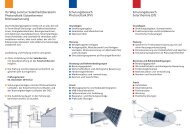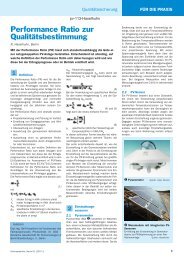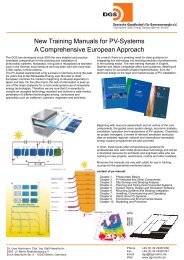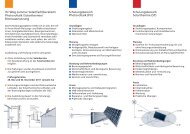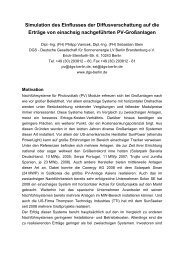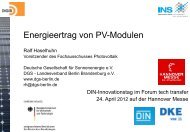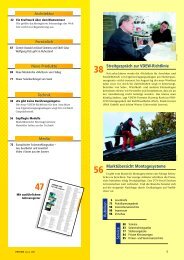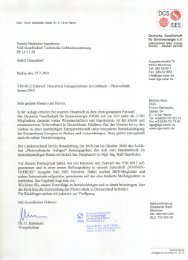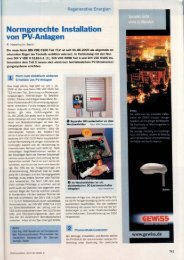NEW VOLTAGE FACTOR - DGS - Landesverband Berlin und ...
NEW VOLTAGE FACTOR - DGS - Landesverband Berlin und ...
NEW VOLTAGE FACTOR - DGS - Landesverband Berlin und ...
Create successful ePaper yourself
Turn your PDF publications into a flip-book with our unique Google optimized e-Paper software.
<strong>NEW</strong> <strong>VOLTAGE</strong> <strong>FACTOR</strong> (VF) FOR PV-MODULES<br />
AND OTHER ASPECTS FOR OPTIMIZATION OF INVERTER SIZING<br />
Dipl.-Ing. Ralf Haselhuhn<br />
<strong>DGS</strong> - Deutsche Gesellschaft für Sonnenenergie LV <strong>Berlin</strong> Brandenburg e.V.<br />
Erich-Steinfurth-Str. 6, 10243 <strong>Berlin</strong><br />
Tel. +49 (30) 293812 – 60, Fax +49 (30) 293812 - 61<br />
rh@dgs-berlin.de<br />
www.dgs-berlin.de<br />
ABSTRACT: This paper aims the optimal sizing of PV-generator and inverter especially by thin film technology.<br />
1 MOTIVATION<br />
More and more different types of PV-modules with<br />
different cell technology are entering the market.<br />
Considering the design of PV-Systems, installers and<br />
planers might make mistakes if they don’t consider that<br />
there are new aspects of inverter sizing.<br />
2 FUNDAMENTALS<br />
The relation between MPP-voltage V MPP and opencircuit-voltage<br />
V OC determines the possibility to use the<br />
whole range of MPP-tracking of the inverter. Therefore a<br />
new voltage factor (VF) was introduced for different pvmodules<br />
in order to simplify the sizing (see tab. 1).<br />
crystalline<br />
ThinFilm<br />
Table 1: Technical data and voltage factor of modules with different cell technologies<br />
3 ANALYSIS<br />
For qualified sizing it is necessary to use the MPPvoltage<br />
and open-circuit-voltage at –10 C° for central<br />
Europe (e.g. germany) and at 0 C° for south Europe.<br />
Therefore the author build these values with the<br />
temperature factor β for MPP-voltage and open-circuitvoltage<br />
(see tab. 2). The MPP temperature factor<br />
referring to monocrystalline, polycrystalline and single<br />
ASi modules were calculated using the method of Toro<br />
and Laschinski [1]. The factor β MPP regarding to all other<br />
modules was assessed by the author [2] considering the<br />
information provided by the manufactures.<br />
manufacturer Type cell technology P MPP [W] η V MPP [V] V 0C [V] I MPP I SC FF VF<br />
aleoSolar S_03/75 mono (Cz) 175 13,7% 35,7 44 4,9 5,2 72,0% 81,4%<br />
EvergreenSolar ES-190-RL poly string ribbon 190 12,7% 26,7 32,8 7,12 8,05 72,0% 81,4%<br />
Sanyo HIP-225HDEE1 HIT 225 16,2% 33,9 41,8 6,64 7,14 75,4% 81,1%<br />
Schott Solar EFG 310 poly EFG 310 12,8% 51,6 63,8 6,1 6,7 73,6% 80,9%<br />
Sharp NU-180E1 mono (Cz) 180 13,7% 23,7 30 7,6 8,37 71,7% 79,0%<br />
Solarworld SW220 poly 230 14,0% 29 36,7 7,95 8,55 73,5% 79,0%<br />
SunPower SPR-315-WHT-i mono (Fz) backcontact 315 19,3% 54,7 64,6 5,76 6,14 79,4% 84,7%<br />
FirstSolar FS-265 CdTe 65 9,0% 63,7 87 1,02 1,17 63,8% 73,2%<br />
FirstSolar FS-280 CdTe 80 11,1% 71,3 94 1,12 1,23 69,1% 75,9%<br />
Kaneka T-SD120 ASi (single) 120 6,3% 67 91,8 1,8 2,38 55,2% 73,0%<br />
Kaneka K75 ASi (single) 75 6,2% 67 92 1,12 1,4 58,3% 72,8%<br />
Kaneka HB110 Micromorph 110 9,1% 54 71 1,87 2,25 63,2% 76,1%<br />
Mitsubishi Heavy MT130 Micromorph 130 8,3% 101 131 1,29 1,53 65,0% 77,1%<br />
Schott Solar ASI TM86 ASi (tandem) 86 5,9% 17,2 23,3 5 5,92 62,3% 73,8%<br />
Sharp NA-901 WQ Micromorph 90 8,5% 49,3 65,2 1,83 2,11 65,6% 75,6%<br />
Sulfurcell SCG60-HV-F CIS 60 7,3% 41,5 52,5 1,5 1,7 69,7% 79,0%<br />
Unisolar PVL-136 Asi (triple) 136 6,3% 33 46,2 4,1 5,1 57,4% 71,4%<br />
WürthSolar WSG0025E080 CIS 80 11,0% 120 160 0,67 0,72 69,8% 75,0%<br />
manufacturer Type cell technology ∪∪∪∪ 0 ∪∪∪∪ MPP V0C -10° VMPP-10° VF-10° V0C 0° VMPP 0° VF 0°<br />
aleoSolar S_03/75 mono (Cz) -0,35% -0,45% 49,4 41,3 83,7% 47,9 39,7 83,0%<br />
EvergreenSolar ES-190-RL poly string ribbon -0,35% -0,49% 36,8 31,3 85,0% 35,7 30,0 84,0%<br />
Sanyo HIP-225HDEE1 HIT -0,27% -0,20% 45,8 36,3 79,3% 44,6 35,6 79,8%<br />
Schott Solar EFG 310 poly EFG -0,35% -0,27% 71,6 56,5 78,9% 69,4 55,1 79,4%<br />
Sharp NU-180E1 mono (Cz) -0,35% -0,45% 33,6 27,4 81,5% 32,6 26,3 80,8%<br />
Solarworld SW220 poly -0,33% -0,44% 40,9 33,5 81,7% 39,7 32,2 81,0%<br />
SunPower SPR-315-WHT-i mono (Fz) backcontact -0,27% -0,20% 70,8 58,6 82,8% 69,0 57,5 83,3%<br />
FirstSolar FS-265 CdTe -0,20% -0,17% 93,1 67,5 72,5% 91,4 66,4 72,7%<br />
FirstSolar FS-280 CdTe -0,20% -0,17% 100,6 75,5 75,1% 98,7 74,3 75,3%<br />
Kaneka T-SD120 ASi (single) -0,31% -0,39% 101,6 76,0 74,8% 98,8 73,4 74,3%<br />
Kaneka K75 ASi (single) -0,30% -0,38% 101,8 76,0 74,7% 99,0 73,4 74,2%<br />
Kaneka HB110 Micromorph -0,35% -0,37% 79,7 61,0 76,5% 77,2 59,0 76,4%<br />
Mitsubishi Heavy MT130 Micromorph -0,33% -0,35% 146,1 113,4 77,6% 141,8 109,8 77,5%<br />
Schott Solar ASI TM86 ASi (tandem) -0,33% -0,41% 26,0 19,7 75,7% 25,2 19,0 75,2%<br />
Sharp NA-901 WQ Micromorph -0,30% -0,32% 72,0 54,8 76,1% 70,1 53,2 76,0%<br />
Sulfurcell SCG60-HV-F CIS -0,26% -0,31% 57,3 46,0 80,3% 55,9 44,7 80,0%<br />
Unisolar PVL-136 Asi (triple) -0,38% -0,31% 52,4 36,6 69,8% 50,6 35,6 70,3%<br />
WürthSolar WSG0025E080 CIS -0,29% -0,34% 176,2 134,3 76,2% 171,6 130,2 75,9%<br />
Table 2: Temperature coefficients and voltage factors at different module temperature considering different cell<br />
technologies [1, 2]<br />
crystalline<br />
ThinFilm
Crystalline silicon modules have typical values of VF<br />
aro<strong>und</strong> 80%,. Generally most crystalline modules showed<br />
values over 80% up to 85%. Thin film-modules show a<br />
lower VF with typical values between 71% and 76%.<br />
However some CIS-modules show the same values as<br />
some crystalline modules.<br />
VF<br />
° = 0<br />
V<br />
MPP 0°<br />
V<br />
OC 0°<br />
VF<br />
− 10°<br />
V<br />
=<br />
V<br />
MPP −10°<br />
OC −10°<br />
Applying the newly introduced factor it’s possible to find<br />
the optimal operating range of the PV-generator. This can<br />
be done comparing the VF with the relation between the<br />
maximum MPP-tracking-voltage VF Inv and the maximum<br />
input voltage of the inverter.<br />
V<br />
VF inv =<br />
V<br />
MPP max<br />
inv max<br />
The voltage factor of the inverter (VF Inv) has to be lower<br />
than the voltage factor of module.<br />
VF inv<br />
≤ n × VF<br />
If this is the case, the PV-generator will operate optimally<br />
in the V MPP-tracking range of the inverter. Considering<br />
the limitation of power and current the PV-generator will<br />
operate optimally in all obtainable working points too.<br />
The green range of figure 1 shows the optimal operating<br />
range with a marked critical range for thin film modules.<br />
Figure 1: Optimal operating rage of inverter [2]<br />
Thus the open circuit voltage of PV generators with<br />
thin film PV-modules might exceed the maximum<br />
inverter voltage at low temperatures, even though the<br />
MPP-values are located within the operating range of the<br />
inverter. Considery the maximum voltage leads to a<br />
reduction of the MPP range of the inverter, particularly<br />
regarding thin film PV modules.<br />
Figure 2: Open circuit voltage of the thin film PV-<br />
Generator exceeds the maximum input voltage of the<br />
inverter by normal sizing<br />
By normal sizing the open circuit voltage of the thin<br />
film PV-generator exceeds the maximum input voltage of<br />
the inverter.Taking into account a correct dimensioning<br />
of voltage, the maximum number of panles in a string can<br />
be calculated applying the resoective MPP an VF values<br />
in the following formula:.<br />
For central Europe:<br />
n<br />
For south Europe:<br />
n<br />
max −10°<br />
C<br />
max 0°<br />
C<br />
VF<br />
=<br />
VF<br />
=<br />
0°<br />
C<br />
−10°<br />
C<br />
V<br />
V<br />
× V<br />
× V<br />
MPP inv max<br />
MPP −10°<br />
C<br />
MPP inv max<br />
MPP 0°<br />
C<br />
4 CONCLUSION<br />
Applying the newly introduced voltage factor VF the<br />
dimensioning of the inverter can be easily realized for all<br />
different module technologies.<br />
5 REFERENCES<br />
[1] Jose del Toro, Joachim Laschinski: Einfaches Modell<br />
für das thermische Verhalten des MPPs; procceding<br />
to OTTI 18th PV-Symposium, Monastery Banz 2004<br />
[2] Ralf Haselhuhn, Claudia Hemmerle; u.a.:<br />
<strong>DGS</strong> - Leitfaden Photovoltaische Anlagen; Deutsche<br />
Gesellschaft für Sonnenenergie e.V., <strong>DGS</strong> <strong>Berlin</strong>,<br />
4 th edition 2009<br />
English edition:<br />
Planning and Installing Photvoltaic Systems guide for<br />
installers, architects and engineers, <strong>DGS</strong> + earthscan<br />
second edition 2008<br />
.



